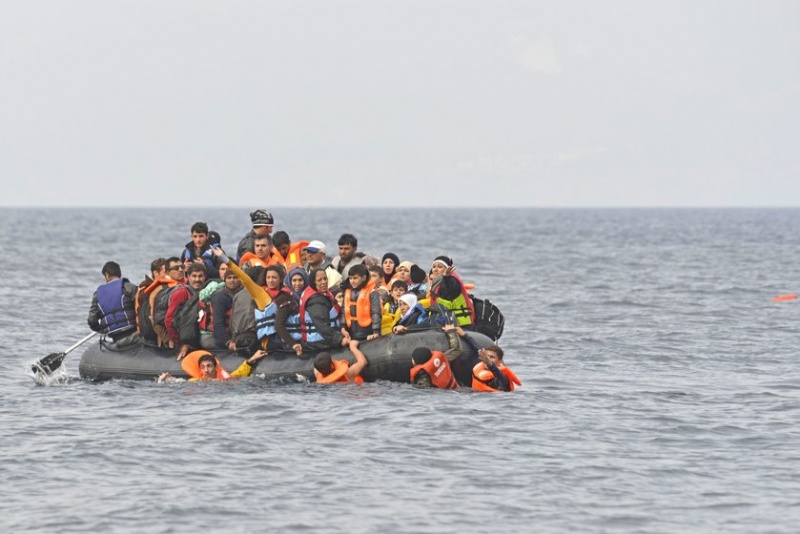
At a press conference held in the last days of August, unrepentant German Chancellor Angela Merkel said that she would “make essentially the same decisions” today if confronted with the same situation as during the migrant crisis of the summer of 2015. And after migrants who had been placed in quarantine on the Greek island of Lesbos set the camp of Moria on fire, completely destroying it, Germany and France announced that they would jointly take 400 minors from the camp. Once again, Angela Merkel expressed her hope that other EU countries would also assume a “shared responsibility” and take their share of migrants from Greece. Merkel thereby sent a clear signal to Africa and the Middle East that if you reach Europe’s shores and then set ablaze the closed migrant centre where the local authorities are keeping you, as was the case with the Moria migrant camp, you will stand a chance of being sent to Germany or France. Although this will give Greece some limited temporary relief, past experience shows that it is bound to generate more pressure at its borders with Turkey, at a time when Ankara is openly using migrants as a weapon in its conflict with Athens. Since the beginning of the year, Greece’s right-wing government, led by Prime Minister Kyriakos Mitsotakis, has been fighting hard against illegal immigration, building a fence on its land border with Turkey, practising “hot returns” of migrants caught on the spot, and putting others in closed camps – just as Hungary has been doing for years, in spite of harsh criticism from Brussels. Thanks to the efforts of Mitsotakis’ government, and in spite of Turkey’s ruthless policy of transporting migrants to the land border with Greece and encouraging them to try to make their way to Greek islands from Turkish beaches, there were “only” 10,689 new arrivals in Greece from January 1 to September 8, 2020, compared with 71,386 for the whole of 2019, according to data published on the website of the International Organization for Migration (IOM). On its islands, where migrants who land on the beaches or are rescued at sea cannot be immediately sent back across the border, Greece has now restricted the free movement of illegal immigrants and asylum seekers, putting them in closed camps. Apart from locals being fed up with their presence and the accompanying insecurity and nuisance, another reason behind this decision to seal migrant centres was of course the ongoing COVID-19 pandemic, with numerous cases of migrants testing positive for the disease. After the migrant centre in Moria was completely destroyed, the Greek government quickly ruled out the transfer to the continent of the more than 12,000 migrants who were left without accommodation, so as not to create a pull effect or an incitement for other migrants to set their own camps ablaze on other islands.
Because of the presence of some 130,000 illegal immigrants stuck in the Balkans, the pressure on Hungary’s and Austria’s southern borders is still high, although most are now heading for Italy. In the case of Hungary, the number of migrants trying to cross the border illegally has remained limited and rather stable. Last spring Hungary suspended the possibility of filing for asylum at the border and closed its border transit zones following a decision by the European Court of Justice which declared them in violation of European law. Henceforth it is only possible to file for asylum in Hungary through a Hungarian consulate in another country. With its southern border fully fenced and monitored, and its laws allowing hot returns of illegals caught near the border and the detention of those who are caught at a later stage, the country under Viktor Orbán has been very successful in fighting illegal immigration, and very few illegal immigrants are now able to make their way through Hungary.
Five years on, Italy is back to square one
Unlike his German counterpart, Austria’s Chancellor Sebastian Kurz considers that Europe took “completely the wrong turn” when it allowed in some one million migrants in 2015. Kurz insists that he “was against open borders from the beginning”, and that “The policy of open borders didn’t just lead to the fact that a lot of people made their way to Europe causing a massive burden in large parts of central Europe”, as “it also meant that the smugglers have earned enormous sums of money and countless people have drowned in the Mediterranean Sea.” “I am glad that five years after the refugee crisis, politics in Europe today is completely changed”, Kurz further told the German news agency dpa at the beginning of September.
But is it really? Not only are the leaders of countries like Germany and France unrepentant over their past policies (and they have not made much progress either in repatriating those illegal immigrants whose asylum claims have been rejected), but one of the three main routes leading through the Mediterranean – the Central Mediterranean route – is wide open again. Indeed, Italy’s left-wing coalition government under Prime Minister Giuseppe Conte, having first closed its ports in April due to the COVID-19 pandemic, proceeded to reopen them a few weeks later, and even created new incentives for potential immigrants to embark on a trip to Italy, either from Libya – thanks to the renewed presence of European NGO ships – or on small boats from Tunisia and Algeria to the island of Lampedusa or other destinations further north.
Thus, while the number of arrivals has fallen this year on the Eastern Mediterranean route to Greece and on the Western Mediterranean route to Spain (with 13,940 arrivals from January 1 to August 31 compared with last year’s 32,513 from January to December, in spite of an eightfold rise in arrivals by sea to the Canary Islands, with more than 4,700 arrivals from the beginning of the year to the first week of September), numbers have increased hugely on the Central Mediterranean route, with 20,399 arrivals in Italy this year, as of September 10, against 11,471 for the full year 2019. Of those who have arrived this year, according to data published by the Italian Ministry of the Interior as of September 11, 41% are Tunisians, 15% are Bangladeshis, 5% are from the Ivory Coast, and 4% are Algerians. The next most represented countries of origin are, in order, Pakistan, Sudan, Morocco, Somalia, Egypt, Afghanistan, and others. The reason why so many Tunisians are now coming to Italy was pointed out by Tunisian MP Sami Ben Abdelaali while on a visit to the migrant centre on Lampedusa in early August: in May, the Conte II government announced a mass amnesty for illegal immigrants, to give them the opportunity to work on farms or as home helpers. True, this amnesty was to apply only to those who were already in Italy before March 8, and the number of legalisation requests made was well below expectations, with just over 200,000 requests instead of the expected 600,000–700,000. However, mass amnesties of illegal immigrants have always been a powerful pull factor, raising hopes of future similar amnesties among potential emigrants. According to Ben Abdelaali, traffickers in Tunisia now lure their clients with promises of a legal stay in Italy, which would give them the right to travel throughout the Schengen area, thanks to false work contracts. Hence, most of the migrants arriving on Italian shores are clearly not refugees, but economic immigrants.
Besides direct arrivals on dinghies or on fishing vessels sailing to the Sicilian island of Lampedusa from nearby Tunisia, several NGOs have their boats operating near Libya again, benefitting from the dismantling of the policies put in place by Salvini. As of early September, several boats were active between Libya and Italy. Among them, the Mare Jonio was the only one belonging to an Italian NGO, Mediterranea Saving Humans. The Open Arms belongs to the Spanish NGO Proactiva Open Arms. Sea-Watch 4 of United4Rescue Initiative, which is backed by the Protestant Church in Germany, is manned by Sea-Watch and Médecins sans frontières. Larger than Sea-Watch 3, Sea-Watch 4 can hold as many as 300 people in normal conditions. A fourth boat, the Louise Michel, sails under a German flag and has been paid for by British street artist Banksy. Its captain, Pia Klemp, a former captain of Sea-Watch 3 and a German far-left activist, recently told The Guardian: “I don’t see sea rescue as a humanitarian action, but as part of an anti-fascist fight.”
Characteristically, over 57% of Italians disapprove of their government’s open ports policy and over 54% consider that their current interior minister, Luciana Lamorgese, should resign, while two-thirds think Italy was more secure when her predecessor, Matteo Salvini, was in office. In late August, the governor of Sicily, Nello Musumeci, called the situation an invasion, and he clashed with the central government in Rome over an order he gave to close migrant camps and send all migrants to mainland Italy, amid concerns linked to the COVID-19 pandemic and the fact that quarantine conditions were not respected among illegal immigrants, many of them fleeing supposedly closed, overcrowded facilities, including some with COVID-19.
While the left-wing Italian government’s lenient immigration policy is decried by a majority of her compatriots, at the beginning of September Interior Minister Luciana Lamorgese continued to demand a compulsory redistribution scheme at European level, calling for the EU Recovery Fund not to be made available to countries that refuse to cooperate.

Olivier Bault
